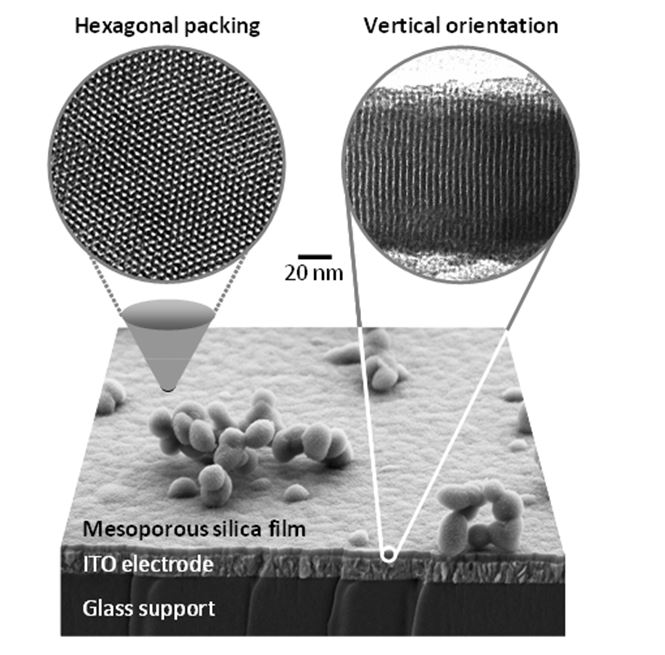Video Article Open Access
Electrochemically Induced Synthesis of Highly Ordered and Vertically Oriented Mesoporous Silica Films
Alain Walcarius
Université de Lorraine, CNRS, LCPME, Nancy, 54600, France
Vid. Proc. Adv. Mater., Volume 2, Article ID 2021-03152 (2021)
DOI: 10.5185/vpoam.2021.03152
Publication Date (Web): 06 May 2021
Copyright © IAAM
Graphical Abstract

Abstract
Ordered mesoporous materials have attracted considerable interest in many research areas and notably in electrochemistry [1]. Dealing with thin film technology, the control of pore orientation is essential for many applications but it was a long-standing challenge, especially for getting well-ordered membranes with small mesopore channels vertically oriented onto the underlying support. Electrochemistry is likely to help on that matter. Indeed, we have discovered that ordered mesoporous silica thin films with mesochannels oriented perpendicular to a solid surface can be generated by electrochemically assisted self-assembly (EASA) [2]. The method combines the electrochemically driven self-assembly of surfactants onto an electrode surface and sol-gel electro-assisted deposition by electrochemical pH tuning at the electrode/solution interface to induce condensation of the precursors in a controlled way. Such vertical orientation of small pores (2-3 nm in diameter) induces fast mass transport rates, which can be exploited for electroanalytical purposes [1]. These films exhibit permselective properties based on charge and size selectivity, with potential applications in molecular sieving, cations sensing, or as antifouling surfaces. Once functionalized with redox-active moieties, which can be achieved by combining electrogeneration and click chemistry, they enable long-range charge transport, making possible the detection of size-excluded redox probes far (~100 nm) from the electrode surface. Indeed, the electrochemically assisted generation of highly ordered azide-functionalized mesoporous silica can be exploited as a versatile platform towards hybrid films with perpendicular mesochannels via click coupling [3]. When these films are functionalized with redox-active moieties, they enable charge transport reactions to occur in such isolating media, via a mechanism of electron hopping between adjacent sites, and this can be exploited for long-range charge transport, e.g., to mediate the electrochemical transformation of size-excluded redox probes [4], with possible applications in the field of molecular electronics for instance. They can be also used in the development of electrochemical sensors, as exemplified for the indirect amperometric detection of non-electroactive species. More recently, they found promising prospects for electrochemical energy storage applications, e.g., as pseudo-capacitor materials [5].
Keywords
Mesoporous silica; electrochemistry; thin films; sensors.
Acknowledgement
This work was supported by CNRS, Université de Lorraine, ICEEL, and by the French PIA project “Lorraine Université d’Excellence” (Reference No. ANR-15-IDEX-04-LUE). I am especially grateful to Neus Vilà from my group for her invaluable contribution to the functionalization of mesoporous silica film electrodes by click chemistry, and to all other colleagues who participated to important developments in the field of EASA.
References
- A. Walcarius, Chemical Society Reviews, 2013, 42, 4098.
- A. Walcarius, E. Sibottier, M. Etienne, J. Ghanbaja, Nature Materials, 2007, 6, 602.
- N. Vilà, E. André, R. Ciganda, J. Ruiz, D. Astruc, A. Walcarius, Chemistry of Materials, 2016, 28, 2511.
- N. Vilà, J. Ghanbaja, E. Aubert, A. Walcarius, Angewandte Chemie International Edition, 2014, 53, 2945.
- J. Wang, N. Vilà, A. Walcarius, ACS Applied Materials Interfaces, 2020, 12, 24262.
Biography
Alain Walcarius received his PhD (1994) from the University of Namur (Belgium). After a postdoctoral stay in the Joe Wang group in New Mexico State University (USA), he joined the CNRS (France) in 1996 as a Research Associate. He is currently Senior Researcher at CNRS and Director of the Laboratory of Physical Chemistry and Microbiology for the Materials and the Environment (LCPME, Nancy, France) where his electrochemistry group works in the area of mesoporous materials, notably by investigating the chemical reactions occurring at solid/liquid interfaces. Among his actual research interests is the intersection between silica-based organic–inorganic hybrid materials, electrochemistry and analytical chemistry, with applications in the field of electrochemical reactors and sensors. He has published ca. 260 scientific papers (> 11 000 citations, h-index 55), 1 book and 12 book chapters, 3 patents, and he gave 95 invited lectures. He is member of the Editorial Board of several journals and he is currently Chair of Division 1 (Analytical Electrochemistry) of the International Society of Electrochemistry (ISE). He is recipient of several awards, including the Analytical Chemistry 2000-Award and the Physical Chemistry Senior 2015-Award of the French Chemical Society, the Tajima Prize 2006 of ISE and elected ISE Fellow in 2016, and he received the Langevin Prize of the French Academy of Science in 2019.
Video Proceedings of Advanced Materials

Upcoming Congress



